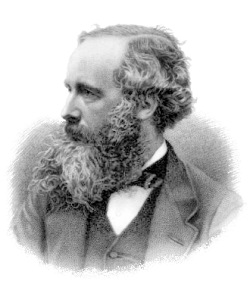

Queer Places:
14 India St, Edinburgh EH3 6EZ, UK
University of Cambridge, 4 Mill Ln, Cambridge CB2 1RZ
16 Palace Gardens Terrace, London W8 4RP, UK
Parton Churchyard
Parton, Dumfries and Galloway, Scotland
Westminster Abbey
Westminster, City of Westminster, Greater London, England
 James Clerk Maxwell FRSE FRS (13 June 1831 – 5 November 1879) was a Scottish mathematician[1][2] and scientist responsible for the classical theory of electromagnetic radiation, which was the first theory to describe electricity, magnetism and light as different manifestations of the same phenomenon. Maxwell's equations for electromagnetism have been called the "second great unification in physics"[3] where the first one had been realised by
Isaac Newton.
With the publication of "A Dynamical Theory of the Electromagnetic Field" in 1865, Maxwell demonstrated that electric and magnetic fields travel through space as waves moving at the speed of light. He proposed that light is an undulation in the same medium that is the cause of electric and magnetic phenomena.[4] The unification of light and electrical phenomena led to his prediction of the existence of radio waves. Maxwell is also regarded as a founder of the modern field of electrical engineering.[5]
Maxwell helped develop the Maxwell–Boltzmann distribution, a statistical means of describing aspects of the kinetic theory of gases. He is also known for presenting the first durable colour photograph in 1861 and for his foundational work on analysing the rigidity of rod-and-joint frameworks (trusses) like those in many bridges.
James Clerk Maxwell FRSE FRS (13 June 1831 – 5 November 1879) was a Scottish mathematician[1][2] and scientist responsible for the classical theory of electromagnetic radiation, which was the first theory to describe electricity, magnetism and light as different manifestations of the same phenomenon. Maxwell's equations for electromagnetism have been called the "second great unification in physics"[3] where the first one had been realised by
Isaac Newton.
With the publication of "A Dynamical Theory of the Electromagnetic Field" in 1865, Maxwell demonstrated that electric and magnetic fields travel through space as waves moving at the speed of light. He proposed that light is an undulation in the same medium that is the cause of electric and magnetic phenomena.[4] The unification of light and electrical phenomena led to his prediction of the existence of radio waves. Maxwell is also regarded as a founder of the modern field of electrical engineering.[5]
Maxwell helped develop the Maxwell–Boltzmann distribution, a statistical means of describing aspects of the kinetic theory of gases. He is also known for presenting the first durable colour photograph in 1861 and for his foundational work on analysing the rigidity of rod-and-joint frameworks (trusses) like those in many bridges.
James Clerk Maxwell was born on 13 June 1831[10] at 14 India Street, Edinburgh, to John Clerk Maxwell of Middlebie, an advocate, and Frances Cay,[11][12] daughter of Robert Hodshon Cay and sister of John Cay. (His birthplace now houses a museum operated by the James Clerk Maxwell Foundation.) His father was a man of comfortable means[13] of the Clerk family of Penicuik, holders of the baronetcy of Clerk of Penicuik. His father's brother was the 6th baronet.[14] He had been born "John Clerk", adding "Maxwell" to his own after he inherited (as an infant in 1793) the Middlebie estate, a Maxwell property in Dumfriesshire.[11] James was a first cousin of both the artist Jemima Blackburn[15] (the daughter of his father's sister) and the civil engineer William Dyce Cay (the son of his mother's brother). Cay and Maxwell were close friends and Cay acted as his best man when Maxwell married.[16] Maxwell's parents met and married when they were well into their thirties;[17] his mother was nearly 40 when he was born. They had had one earlier child, a daughter named Elizabeth, who died in infancy.[18] When Maxwell was young his family moved to Glenlair, in Kirkcudbrightshire, which his parents had built on the estate which comprised 1,500 acres (610 ha).[19]
In October 1850, already an accomplished mathematician, Maxwell left Scotland for the University of Cambridge. He initially attended Peterhouse, but before the end of his first term transferred to Trinity, where he believed it would be easier to obtain a fellowship.[42] At Trinity he was elected to the elite secret society known as the Cambridge Apostles.[43] Maxwell's intellectual understanding of his Christian faith and of science grew rapidly during his Cambridge years. He joined the "Apostles", an exclusive debating society of the intellectual elite, where through his essays he sought to work out this understanding.
His discoveries helped usher in the era of modern physics, laying the foundation for such fields as special relativity and quantum mechanics. Many physicists regard Maxwell as the 19th-century scientist having the greatest influence on 20th-century physics. His contributions to the science are considered by many to be of the same magnitude as those of Isaac Newton and Albert Einstein.[6] In the millennium poll—a survey of the 100 most prominent physicists—Maxwell was voted the third greatest physicist of all time, behind only Newton and Einstein.[7] On the centenary of Maxwell's birthday, Einstein described Maxwell's work as the "most profound and the most fruitful that physics has experienced since the time of Newton".[8] Einstein, when he visited the University of Cambridge in 1922, was told by his host that he had done great things because he stood on Newton's shoulders; Einstein replied: "No I don't. I stand on the shoulders of Maxwell."[9]
My published books: